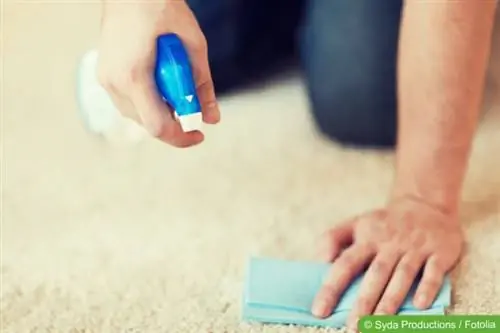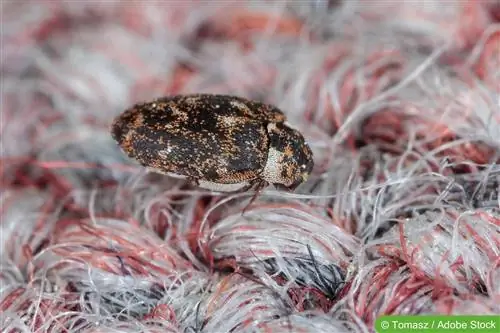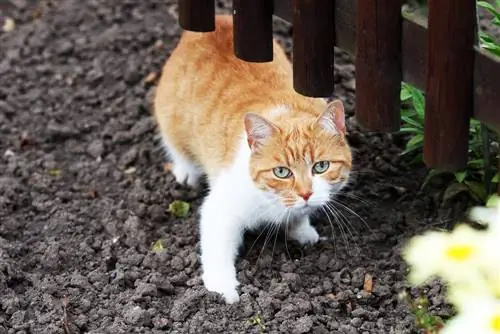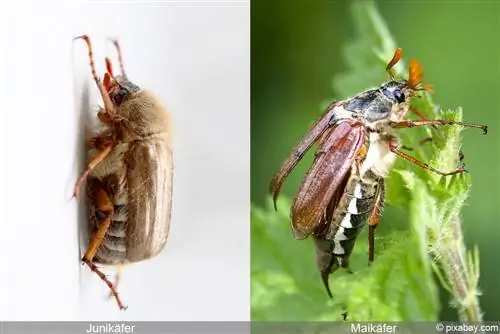- Author admin [email protected].
- Public 2023-12-17 03:39.
- Last modified 2025-01-24 12:45.
Hardly anyone knows the pretty, nectar-loving carpet beetle. Few people know that the voracious larvae like to hatch from their eggs indoors. There they find enough food until they are big enough to continue living as beetles. The larva not only damages materials, but is also harmful to he alth. Reason enough to combat them with the right means. Here are the best remedies and measures to get rid of carpet beetles.
Appearance
- Beetle: oval, 3-4 mm, black with orange-red, white spots
- Eggs: 1/2 millimeter, whitish
- Larva: 6 mm long, dense hair, arrow hairs (longer hairs, covered with barbs)
Lifecycle
The finished beetles live in the wild. They fly from flower to flower. This is also where males and females find each other. The female carpet beetle, which was just in love with the sun, is now afraid of the brightness and seeks out dark corners. These are often rarely cleaned corners in attics, houses or apartments. In May/June the female carpet beetle lays 30-40 eggs in such places. Depending on the room temperature (room temperature is optimal), the voracious larvae hatch after 15 days. The warmer the ambient temperature, the shorter the larval period. The pupal stage lasts about 20 days at normal room temperature. The larva eats its way through the house until nature provides enough warmth and flowers for a small beetle in spring. The beetle's sunny life only lasts for a month. These are all very short time intervals. Under poor conditions, the larva can remain in a dormant state for a good year.
Habitat, food

While the carpet beetle flies from flower to flower in its short life, the larvae prefer to hatch in houses and apartments. Bird nests are actually one of the natural breeding stations for larvae. Ultimately, all that matters is a richly laid table. They feed primarily on keratin. These are natural fiber proteins, like those in hair. Nails, skin flakes and feathers occur.
Tip:
Typical hiding places are upholstered spaces, floors under beds and sofas, carpets, wardrobes, chests with textiles, bed boxes and rarely used shoes and bags.
Damage
An infestation of carpet beetle larvae can be determined by the feeding marks. Irregular holes can be discovered on textiles such as carpets, blankets, curtains or clothing. However, before targeted countermeasures can begin, the enemy must be clearly identified. Other so-called material pests, such as the clothes moth, the fur beetle or the ball beetle, also leave traces of feeding on textiles. Textiles that are contaminated by sweat, skin flakes or leftover food are particularly attractive. He alth can also suffer. Sensitive people and people who are prone to allergies sometimes react very strongly to the larvae's arrow hairs, which cause irritation to the respiratory tract. To identify the pest, sticky traps can first be laid out. This means that the material pest cannot be completely combated, but at least you can see who it is after a very short time.
Prevention
Depriving the carpet beetle and its larvae and eggs of their livelihoods is of course the best measure. In other words, clean regularly wherever the larvae prefer to stay or where the beetles lay their eggs.
- Check and clean attics and basements regularly for dead animals (mice, insects).
- Suck or beat out carpets and upholstery cracks with powerful vacuum cleaners.
- Depilate and wash pet cages, blankets and pillows regularly.
- Clean under beds and other furniture regularly.
- Now and then move heavy furniture from the walls, check for cracks in the wall and clean thoroughly.
Despite all preventative measures, infestations can still occur again and again. Often this is due to the location of the house, for example if there are many bird nests nearby. In this case, additional preventive measures are necessary.
- tight fly screens in front of the windows
- pay attention to tight window frames and tight masonry
- cultivate appropriate defensive plants at windows and entrances, such as lavender

Natural remedies for carpet beetles
Fortunately, some natural remedies also help to combat the beetle and its larvae. There are some natural-based insecticides commercially available that have a good effect. They are mostly based on:
- Lavender
- Cedarwood
- Tea tree oil
- Neem oil
- fossil plankton
- Pyrethrum (from chrysanthemums)
These substances make purely chemical insecticides unnecessary. They are harmless to humans and animals. Such products are always the better choice, especially in a household with children or pets. Bags of dried lavender sachets provide protection for up to three months. This can be used to protect all kinds of textiles, especially in cupboards and chests, from infestation. Rings made of cedar wood also keep carpet beetles away. Fossil plankton is another non-toxic and very effective weapon. It's basically a kind of algae powder. The powder must be sprinkled in appropriate places. It attaches itself to larvae and beetles and they dry out. Then they just need to be vacuumed or wiped.
Falling
The adhesive trap mentioned at the beginning is a first aid measure. Everything that bothers and eats sticks here. From moths to silverfish to carpet beetles. These traps should be placed in the appropriate places and replaced after a certain period of time. Then there are pheromone traps. They differ from sticky traps in that they use their scent to attract pests, which then stick to them. If that's understandably not something you're comfortable with, it's best to set up this type of trap outside the house.
Heat and cold
Physical combat is also possible. It is suitable for infected textiles. Carpet beetles neither like the cold nor can they survive temperatures above 60 °C. A 60°C wash is a good measure. The larvae also surrender in the oven at temperatures above 60°C. You can use your hot steam cleaner to treat upholstery and (some) carpets. Delicate textiles can be freed from pests in the freezer compartment of the refrigerator. To do this, they have to be stored there for a day, preferably in a bag.
Tip:
To solve the problem of carpet beetles in the long term, it is best to combine and repeat different measures.
This way you can catch them in multiple life cycles and at the same time prevent a new generation from settling down.
Conclusion of the editors
An infestation of carpet beetles and their larvae is anything but insignificant. But it can be de alt with quite easily with relatively little effort and, above all, with non-toxic means. The accompanying, necessary, thorough cleaning of the furthest corners also gives a really good feeling of living again.
What you should know about carpet beetles soon
Recognize
- Similar to the clothes moth, the carpet beetle attacks textiles made from natural materials.
- They are often discovered in winter - the animals particularly like the warmth in their houses.
- They then lay their eggs there and it is not the carpet beetle itself that is the pest, but rather the larvae.
- These can be up to 6 mm long and are therefore easy to see with the naked eye.
- They love dark corners, for example in drawers or in cupboards and bed drawers.
- There they feed on wool, fur or even feathers. They even don't stop at fillings in mattresses - for example made of horsehair.
- The beetle itself, however, only feeds on plant substances.
Combat
- The eggs can usually be recognized by their shape and color: they are whitish and approx. 0.7 x 0.3 mm in size.
- The larvae are black-brown and hairy.
- The beetle itself is only 3 - 4 mm in size and is predominantly black with white and a reddish cord on the back.
- Anyone who has discovered an infestation should fight the beetles and/or larvae as quickly as possible.
- Not only is the damage caused by feeding problematic, but the beetles also often trigger allergies in humans.
- First of all: vacuum everything thoroughly! Also think about various nooks and crannies that like to be populated.
- In addition, there are special products commercially available to combat the larvae - e.g. contact insecticides.
- There is a good selection in specialist shops - either as “chemical clubs” or natural preparations.
- It is also possible to expose the infested textiles to a temperature of 60 °C for several hours - the pests will not survive that.
- Caution: Wool clothing usually cannot be washed at such a high temperature. Sometimes - if possible - ironing is a good alternative.
- If the infestation has progressed too far, the only solution is to remove and dispose of the affected parts.
Prevention
- If you want to prevent an infestation, you should vacuum and clean the cupboards regularly.
- If they are packed too full, there will be insufficient air supply.
- Valuable clothing such as woolen clothes and furs can be packed in plastic bags and stored in a protected manner.
- Under no circumstances should you put worn clothes back in the closet!
- Smell of sweat or small flakes of skin make the clothing particularly attractive to the larvae.
- Anyone who owns a pet should definitely remove hair, feathers and other things regularly.
- An abandoned bird's nest in front of the house should also be removed to be on the safe side.
- Regular ventilation and furniture that is slightly away from the wall can also have a preventative effect.
- Upholstered furniture and carpets must also be vacuumed or cleaned regularly.






